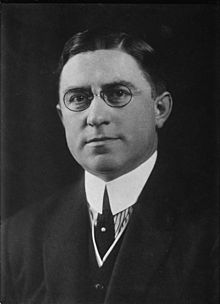Louis T. McFadden
Louis Thomas McFadden | |
|---|---|
 | |
| Member of the U.S. House of Representatives from Pennsylvania's 14th district | |
| In office 1915–1923 | |
| Preceded by | William D.B. Ainey |
| Succeeded by | William M. Croll |
| Member of the U.S. House of Representatives from Pennsylvania's 15th district | |
| In office 1923–1935 | |
| Preceded by | Edgar R. Kiess |
| Succeeded by | Charles E. Dietrich |
| Personal details | |
| Born | thumb July 25, 1876 Granville Center, Troy Township, Bradford County, Pennsylvania |
| Died | October 1, 1936 (aged 60) New York City |
| Resting place | thumb Louis T. McFadden |
| Political party | Republican |
| Parent |
|
Louis Thomas McFadden (July 25, 1876 – October 1, 1936) was a Republican member of the U.S. House of Representatives from Pennsylvania.
Early life
McFadden was born in Granville Center, Troy Township, Bradford County, Pennsylvania. He graduated from Warner's Commercial College in Elmira, New York. In 1892 he entered the employ of the First National Bank in Canton, Pennsylvania. In 1899 he was elected cashier, and became its president on January 11 1916, serving until 1925.[1]
He served as treasurer of the Pennsylvania Bankers’ Association in 1906 and 1907, and as president in 1914 and 1915.[1] He was appointed in 1914 by the agricultural societies of the State of Pennsylvania as a trustee of Pennsylvania State College.[1]
Political career
In 1914, McFadden was elected as a Republican Representative to the Sixty-fourth Congress and to the nine succeeding Congresses.[1] He served as Chairman of the United States House Committee on Banking and Currency during the Sixty-sixth through Seventy-first Congresses, or 1920-31.[1] Though re-elected without opposition in 1932, in 1934 he lost to the Democratic nominee by 561 votes.[citation needed] He was an unsuccessful candidate for nomination in 1936.[1]
McFadden's main official legacy was the working on and the passing of the McFadden Act of 1927 limiting federal branch banks to the city in which the main branch operates. The Act sought to give national banks competitive equality with state-chartered banks by letting national banks branch to the extent permitted by state law. The McFadden Act specifically prohibited interstate branching by allowing national banks to branch only within the state in which it is situated. Although the Riegel-Neal Interstate Banking and Branching Efficiency Act of 1994 repealed this provision of the McFadden Act, it specified that state law continues to control intrastate branching, or branching within a state's borders, for both state and national banks.[citation needed]
McFadden is also remembered for his criticism of the Federal Reserve, which he claimed was created and operated by European banking interests who conspired to economically control the United States. On June 10, 1932, McFadden made a 25-minute speech before the House of Representatives[2] , in which he accused the Federal Reserve of deliberately causing the Great Depression. McFadden also claimed that Wall Street bankers funded the Bolshevik Revolution[3] through the Federal Reserve banks and the European central banks with which it cooperated. McFadden moved to impeach President Herbert Hoover in 1932, and also introduced a resolution bringing conspiracy charges against the Board of Governors of the Federal Reserve. The impeachment resolution was defeated by a vote of 361 to 8; it was seen as a big vote of confidence to President Hoover from the House.[4]
In 1933, he introduced House Resolution No. 158, articles of impeachment for the Secretary of the Treasury, two assistant Secretaries of the Treasury, the Board of Governors of the Federal Reserve, and the officers and directors of its twelve regional banks[5].
McFadden died in 1936 on a visit to New York City and was interred in East Canton Cemetery in Canton, Pennsylvania.[1]
References
- ^ a b c d e f g
- United States Congress. "Louis T. McFadden (id: M000434)". Biographical Directory of the United States Congress.
- ^ Congressional Record June 10 1932
- ^ Wall Street and the Bolshevic Revolution A.Sutton
- ^ ""I Impeach. . . ."". TIME. December 26, 1932. Retrieved 2007-09-15.
- ^ Congressional record - May 23, 1933 Pg 4055 - 4058
External links
- Flaherty, Edward, Ph.D. The Legendary Tirade of Louis T. McFadden — Article criticizing McFadden's speech against the Federal Reserve.
- The Political Graveyard
